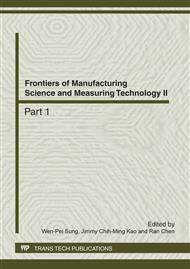[1]
A. K. Shrestha, J. Arcot, J. L. Paterson, Edible coating materials—their properties and use in the fortification of rice with folic acid, Food Res. Int. 36 (2003) 921–928.
DOI: 10.1016/s0963-9969(03)00101-7
Google Scholar
[2]
Ó. L. Ramos, S. I. Silva, J. C. Soares, Features and performance of edible films, obtained from whey protein isolate formulated with antimicrobial compounds, Food Res. Int. ( 2011) 1-11.
DOI: 10.1016/j.foodres.2011.09.016
Google Scholar
[3]
V. Falgueraa, J. P. Quintero, A. Jim_enez, Edible films and coatings: Structures, active functions and trends in their use, Trends Food Sci. Technol. 22 (2011) 292-303.
DOI: 10.1016/j.tifs.2011.02.004
Google Scholar
[4]
J. Osés, M. Fabregat-Vázquez, R. Pedroza-Islas, Development and characterization of composite edible films based on whey protein isolate and mesquite gum, J. Food Eng. 92 (2009) 56–62.
DOI: 10.1016/j.jfoodeng.2008.10.029
Google Scholar
[5]
S.S. Silva, B.J. Goodfellow, J. Benesch, Morphology and miscibility of chitosan/soy protein blended membranes, Carbohydr. Polym. 70 (2007) 25–31.
DOI: 10.1016/j.carbpol.2007.02.023
Google Scholar
[6]
T. Sivarooban, N.S. Hettiarachchy , M.G. Johnson, Physical and antimicrobial properties of grape seed extract, nisin, and EDTA incorporated soy protein edible films, Food Res. Int. 41 (2008) 781–785.
DOI: 10.1016/j.foodres.2008.04.007
Google Scholar
[7]
Standard test method for water vapor transmission of materials, ASTM. E 96-93(1993)701–708.
Google Scholar
[8]
Y. Jiang, C.H. Tang, Q.B. Wen, Effect of processing parameters on the properties of transglutaminase-treated soy protein isolate films, Innovat Food Sci Emerg Tech. 8(2007), 218–225.
DOI: 10.1016/j.ifset.2006.11.002
Google Scholar
[9]
D. Kowalczyk, B. Baraniak, Effects of plasticizers, pH and heating of film-forming solution on the properties of pea protein isolate films, J. Food Eng. 105 (2011)295–305.
DOI: 10.1016/j.jfoodeng.2011.02.037
Google Scholar


